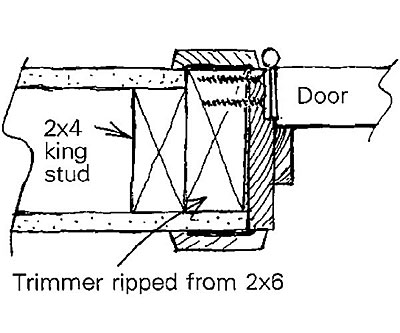
If you think about how most doors are mounted to most jambs and visualize the relationship of hinge-to-door and hinge-to-jamb, you may see some room for improvement. Standard butt hinges, heavy-duty or not, have a hole pattern that permits two screws at best to reach the framing trimmer. The thicker the wall finish, the more tenuous is the screw’s anchoring ability. When the doors are light, the holding power of the screws will most probably be adequate. But when the hinges on heavy, solid-core doors are secured to such minimal backing, the hinges can pull away from the jamb over time.
My solution to this problem is to rip a trimmer that equals the width of the king stud plus the thickness of the wall finish. As shown in the drawing, the deep trimmer allows full backing for the hinges. The wall finish abuts the edge of the trimmer, so the casings should be wide enough to conceal the joint between them.
By the way, if you choose to let the trimmer overlap on both sides of the door there are two advantages: the framing is prepared for a door to be hung on either side of the jamb; and the drywallers will be forced to cut their drywall to fit, meaning the drywall won’t extend past the trimmer, which makes it a chore to install the shims.
M. F. Marti, Ridgway, CO

Click the "thumbs up" button above to vote for this tip. Help us choose Fine Homebuilding's top-10 window and door tips.























View Comments
good idea, but in the retrofit situation i do this:
cut back the drywall behind the casing and glue and staple 1 1/2" wide rips of 1/2" plywood to the hinge side of the jambs. works well